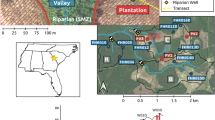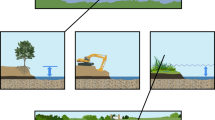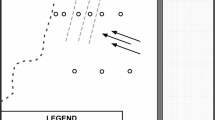Abstract
Floodplain restoration has been advocated as a means to restore several ecological services associated with floodplains: water quality improvement, fish rearing habitat, wildlife habitat, flood control, and groundwater recharge. A history of agricultural encroachment on the lower Cosumnes River has resulted in extensive channelization and levee construction. In fall 1998, an experimental floodplain was established by breaching a levee in order to restore the connection between the main channel and its historic floodplain. In this study, we examined how effective this newly restored floodplain was at processing nitrate (NO −3 ) before reentering the main channel downstream. Two methods were used to examine nitrate loss. In December 2001, we determined denitrification potentials of the floodplain soils before seasonal flooding inundated the floodplain. Next, we conducted a series of field soil column (mesocosm) experiments from March to June 2002 to study NO −3 -N loss from the overlying water in both sandy and clayey soils and at three levels of NO −3 -N (ambient, +1 mg N l−1, +5 mg N l−1). In addition, we examined NO −3 -N loss from mesocosms with water only to determine if loss was related primarily to soil or water column processes. Denitrification potentials were highly variable ranging from 1.6 to 769 ng N2O–N cm−3 h−1. In addition, the denitrification potential was highly correlated with the amount of bioavailable carbon indicating that carbon was a limiting factor for denitrification. Nitrate-N loss rates from mesocosms ranged from 2.9 to 21.0 μg N l−1 h−1 over all treatments and all 3 months examined. Significant loss of NO −3 -N (60–93%) from the water only treatment only occurred in June when warmer temperatures and solar radiation most likely increased NO −3 -N uptake by phytoplankton. When scaled up, potential NO −3 -N loss from the restored floodplain represented 0.6–4.4% of the annual N load from the Lower Cosumnes River during a typical wet year and ~24% during a dry year. During dry water years, the effectiveness of the floodplain for reducing nitrate is limited by the amount of N supplied to the floodplain. Results from this study suggest that restored floodplains can be an effective NO −3 sink.
Similar content being viewed by others

References
Ahearn D. S., Sheibley R. W., Dahlgren R. A., Anderson M. and Johnson J. (2005). Land use and land cover influence on water quality in the last free-flowing river draining the western Sierra Nevada, California. Journal of Hydrology 313: 234–247
Ahearn D. S., Sheibley R. W., Dahlgren R. A. and Keller K. E. (2004). Temporal dynamics of stream water chemistry in the last free-flowing river draining the western Sierra Nevada, California. Journal of Hydrology 295: 47–63
(1997). Official Methods of Analysis of AOAC International. Association of Analytical Communities International, Arlington, VA
Atwater, B. F. & D. E. Marchand, 1980. Preliminary maps showing late cenezoic deposits of the Bruceville, Elk Grove, Florin, and Galt 7.5-minute quadrangles, Sacramento and San Joaquin Counties, CA. USGS Open File Report 80-849. Sacramento, CA
Beman J. M., Arrigo K. R. and Matson P. A. (2005). Agricultural runoff fuels large phytoplankton blooms in vulnerable areas of the ocean. Nature 434: 211–214
Breitburg D. L. (1990). Near-shore hypoxia in the Chesapeake Bay – patterns and relationships among physical factors. Estuarine Coastal and Shelf Science 30: 593–609
Chen Y. L. L., Chen H. Y., Karl D. M. and Takahashi M. (2004). Nitrogen modulates phytoplankton growth in spring in the South China Sea. Continental Shelf Research 24: 527–541
Christensen S., Simkins S. and Tiedje J. M. (1990). Spatial variation in denitrification – dependency of activity centers on the soil environment. Soil Science Society of America Journal 54: 1608–1613
Crain P. K., Whitner K. and Moyle P. B. (2004). Use of a restored central California floodplain by larvae of native and alien fishes. American Fisheries Society Symposium 39: 125–140
Dahl T. E. (1990). Wetland losses in the United States, 1780s to 1980s, U.S. Fish and Wildlife Service, Washington, DC
Davis J. C. and Minshall G. W. (1999). Nitrogen and phosphorus uptake in two Idaho (USA) headwater wilderness streams. Oecologia 119: 247–255
Duff J. H., Pringle C. M. and Triska F. J. (1996). Nitrate reduction in sediments of lowland tropical streams draining swamp forest in Costa Rica: an ecosystem perspective. Biogeochemistry 33: 179–196
Faber P. A., Keller E., Sands A. and Masser B. M. (1989). The Ecology of Riparian Habitats of the Southern California Coastal Region: A Community Profile. Biological Report 85(7.27). U.S. Fish and Wildlife Service, Washington, DC
Florsheim J. L. and Mount J. F. (2002). Restoration of floodplain topography by sand-splay complex formation in response to intentional levee breaches, Lower Cosumnes River, California. Geomorphology 44: 67–94
Haycock N. E., Pinay G. and Walker C. (1993). Nitrogen-retention in river corridors – European perspective. Ambio 22: 340–346
Humple D. L. and Geupel G. R. (2002). Autumn populations of birds in riparian habitat of California’s Central Valley. Western Birds 33: 34–50
Hunter J. C., Willett K. B., McCoy M. C., Quinn J. F. and Keller K. E. (1999). Prospects for preservation and restoration of riparian forests in the Sacramento Valley, California, USA. Environmental Management 24: 65–75
Junk, W. J., P. B. Bayley & R. E. Sparks, 1989. The flood pulse concept in river-floodplain systems. In Dodge, D. P. (ed.), Proceedings of the International Large River Symposium, Canadian Special Publication in Fisheries and Aquatic Sciences 106: 110–127
Katibah E. F., Drummer K. J. and Nedeff N. E. (1984). Current condition of riparian resources in the Central Valley of California. In: Warner, R. E. and Hendrix, K. M. (eds) California Riparian Systems: Ecology, Conservation, and Productive Management, pp 315–322. University of California Press, Berkeley, CA
Kratzer C. R., Dileanis P. D., Zamora C., Silva S., Kendall C., Bergamaschi B. A. and Dahlgren R. A. (2004). Sources and Transport of Nutrients, Organic Carbon, and Chlorophyll-a in the San Joaquin River Upstream of Vernalis, California, during Summer and Fall, 2000 and 2001. U.S.G.S. Water-Resources Investigations Report 03–4127, Sacramento, CA
Lehman P. W., Sevier J., Giulianotti J. and Johnson M. (2004). Sources of oxygen demand in the lower San Joaquin River, California. Estuaries 27: 405–418
Leonardson L., Bengtsson L., Davidsson T., Persson T. and Emanuelsson U. (1994). Nitrogen-retention in artificially flooded meadows. Ambio 23: 332–341
Modde T., Muth R. T. and Haines G. B. (2001). Floodplain wetland suitability, access, and potential use by juvenile razorback suckers in the middle Green River, Utah. Transactions of the American Fisheries Society 130: 1095–1105
Mount J. F. (1995). California Rivers and Streams: The Conflict between Fluvial Process and Land Use. University of California Press, Berkeley, CA
Mulholland P. J. (2004). The importance of in-stream uptake for regulating stream concentrations and outputs of N and P from a forested watershed: evidence from long-term chemistry records for Walker Branch watershed. Biogeochemistry 70: 403–426
Naiman R. J. and Decamps H. (1997). The ecology of interfaces: riparian zones. Annual Review of Ecology and Systematics 28: 621–658
Olde Venterink H. O. and Hummelink E. (2003). Denitrification potential of a river floodplain during flooding with nitrate-rich water: grasslands versus reedbeds. Biogeochemistry 65: 233–244
Parkin T. B. (1987). Soil microsites as a source of denitrification variability. Soil Science Society of America Journal 51: 1194–1199
Peterson B. J., Wollheim W. M., Mulholland P. J., Webster J. R., Meyer J. L., Tank J. L., Marti E., Bowden W. B., Valett H. M., Hershey A. E., McDowell W. H., Dodds W. K., Hamilton S. K., Gregory S. and Morrall D. D. (2001). Control of nitrogen export from watersheds by headwater streams. Science 292: 86–90
Pinay G., Haycock N. E., Ruffinoni C. and Holmes R. M. (1994). The role of denitrification in nitrogen removal in river corridors. In: Mitsch, W. J. (eds) Global Wetlands: Old World and New, pp 107–117. Elsevier, Dordrecht
Pinay G., Roques L. and Fabre A. (1993). Spatial and temporal patterns of denitrification in a riparian forest. Journal of Applied Ecology 30: 581–591
Rabalais N. N., Turner R. E. and Wiseman W. J. (2001). Hypoxia in the Gulf of Mexico. Journal of Environmental Quality 30: 320–329
Rabalais N. N., Wiseman W. J., Turner R. E., SenGupta B. K. and Dortch Q. (1996). Nutrient changes in the Mississippi River and system responses on the adjacent continental shelf. Estuaries 19: 386–407
Richardson W. B., Strauss E. A., Bartsch L. A., Monroe E. M., Cavanaugh J. C., Vingum L. and Soballe D. M. (2004). Denitrification in the Upper Mississippi River: rates, controls, and contribution to nitrate flux. Canadian Journal of Fisheries and Aquatic Sciences 61: 1102–1112
Sheibley R. W., Duff J. H., Jackman A. P. and Triska F. J. (2003). Inorganic nitrogen transformations in the bed of the Shingobee River, Minnesota – Integrating hydrologic and biological processes using sediment perfusion cores. Limnology and Oceanography 48(3): 1129–1140
Sheldrick B. H. and Wang C. (1993). Particle-size distribution. In: Carter, M. R. (eds) Soil Sampling and Methods of Analysis, Canadian Society of Soil Science, pp 499–511. Lewis Publishers, Ann Arbor, MI
Smith M. S. and Tiedje J. M. (1979). Phases of denitrification following oxygen depletion in soil. Soil Biology & Biochemistry 11: 261–267
Sommer T., Baxter R. and Herbold B. (1997). Resilience of splittail in the Sacramento San Joaquin estuary. Transactions of the American Fisheries Society 126: 961–976
Spink A., Sparks R. E. and Verhoeven J. T. A. (1998). Nutrient dynamics of large river floodplains. Regulated Rivers-Research & Management 14: 203–216
Strauss E. A., Richardson W. B., Bartsch L. A., Cavanaugh J. C., Bruesewitz D. A., Imker H., Heinz J. A. and Soballe D. M. (2004). Nitrification in the Upper Mississippi River: patterns, controls, and contribution to the NO −3 budget. Journal of the North American Benthological Society 23: 1–14
Tilman D., Cassman K. G., Matson P. A., Naylor R. and Polasky S. (2002). Agricultural sustainability and intensive production practices. Nature 418: 671–677
Tilman D., Fargione J., Wolff B., D’Antonio C., Dobson A., Howarth R., Schindler D., Schlesinger W. H., Simberloff D. and Swackhamer D. (2001). Forecasting agriculturally driven global environmental change. Science 292: 281–284
Ward J. V. and Stanford J. A. (1995). Ecological connectivity in alluvial river ecosystems and its disruption by flow regulation. Regulated Rivers-Research & Management 11: 105–119
Weiss R. F. and Price B. A. (1980). Nitrous-oxide solubility in water and seawater. Marine Chemistry 8: 347–359
Yoshinari T. and Knowles R. (1976). Acetylene inhibition of nitrous-oxide reduction by denitrifying bacteria. Biochemical and Biophysical Research Communications 69: 705–710
Zimmerman A. R. and Canuel E. A. (2000). A geochemical record of eutrophication and anoxia in Chesapeake Bay sediments: anthropogenic influence on organic matter composition. Marine Chemistry 69: 117–137
Author information
Authors and Affiliations
Corresponding author
Rights and permissions
About this article
Cite this article
Sheibley, R.W., Ahearn, D.S. & Dahlgren, R.A. Nitrate loss from a restored floodplain in the Lower Cosumnes River, California. Hydrobiologia 571, 261–272 (2006). https://doi.org/10.1007/s10750-006-0249-2
Received:
Revised:
Accepted:
Published:
Issue Date:
DOI: https://doi.org/10.1007/s10750-006-0249-2



